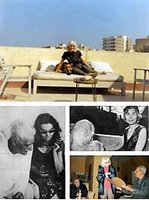
By Hala Halim - Al-Ahram Weekly On-line
Issue No. 797, June 1-7, 2006
Hala Halim remembers Dea Al-Saqqaf (1919-2006)
"O my beloved Jalal Al-Din Al-Rumi :
At the beginning of Al-Mathnawi, you recount the story of a nayy [ flute ]
that had been part of a tree in the forest then was severed from its source,
and now it sobs its yearning to be reunited...
O my beloved ! "
-- Abkar Al-Saqqaf, "Wamadat", Al-Qahira (May 1996)
How to write an obituary of an extraordinary woman known, in her waning years, as a family friend?
Considering the life of Dea Al-Saqqaf (1919-2006), I cannot but think of Hannah Arendt on the twists and turns of Walter Benjamin's life, the posthumous fame and the "element of bad luck" that went into it, encapsulated in his being haunted by the "little hunchback", a figure from German fairy tales who bungles things for children. The "little hunchback" certainly seemed to have been busy in Dea's life, though she would perhaps have said that applied more to her sister, Abkar Al-Saqqaf (1913-1990). Indeed, it is impossible to write about one sister without writing about the other, so inextricably bound were their lives, despite the marked difference in their personality.
Abkar, the writer, and Dea, the artist: born to a distinguished family name and wealth, and blessed with talent; their prospects must have seemed great, the descent from there steep, and when fame came for Abkar it was posthumous fame, thanks largely to Dea's having devoted her final years to her sister's legacy and giving no thought to her own.
In appearance, as in personality, the two sisters could not have been more different. Well into old age Abkar retained traces of her beauty, her poise and an attendant vanity that required stylish, if no longer fashionable, suits, accessories and golden sandals. Dea, whose features were more visibly Asian, her slim figure always clad in simple clothes, had the air of a hermit. Where they met intellectually was in their skepticism, their suspicion of narrow dogma, and their mystical turn of mind; neither sister was afraid of death, seeing it only as a transition, a "reunion" with the "source". Abkar was steeped in the traditions of Sufism, and variations on these themes were the staple of her books and resonate in her poetry. To this shared vision Dea brought her readings in science -- particularly astronomy, a subject that held great fascination for her -- especially when science appeared to corroborate an "intelligent universe" (the title of a book by Fred Hoyle she often cited).
Their intellectual pursuits led to many friendships and correspondences with scholars and writers, their acquaintances including Muhammad Aboul-Uyoun, secretary-general of Al-Azhar, Muharram Kamal, the director-general of the Egyptian Museum who offered guidance with Abkar's research on religious beliefs in Ancient Egypt, the poet Ibrahim Nagui, and the writer Abbas Mahmoud Al-Aqqad, whose salon Abkar frequented and who, in the 1960s, as head of the literary committee of the Ministry of Culture, commissioned Abkar to write Israil Wa 'Aqidat Al-Ard Al-Maw'uda (Israel and the Doctrine of the Promised Land, published in 1967).
Throughout the 1950s, Abkar was at work on a three-volume book, Nahw Afaq Awsa': Al-'Aql Al-Insani Fi Marahilihi Al-Tatawuriyya (Towards Broader Horizons: The Human Mind in its Evolutionary Stages), an ambitious project that provided a comparative analysis of the development of religious thought in different cultures. The first two volumes were published by the Anglo-Egyptian Press in 1962, but were soon banned by Al-Azhar and withdrawn from the market, while the third volume remained unpublished, together with the manuscripts of several books the writer did not have the means to print.
After Abkar's death Dea resolved to get as much of her work published as possible. She commissioned Mahdi Mustafa, a poet who had worked as editor for a while at the progressive Dar Sina publishing house in Cairo. On his first visit to the villa in Alexandria, Mahdi recounts, Dea gave him a suitcase full of manuscripts and letters, pleading with him to help her save her sister's legacy (one thinks of Benjamin again, at the border, lugging the suitcase that contained his manuscripts). Mahdi says that when he later browsed through the material he was stunned, and that he returned it, saying it was a "treasure" to be kept by Dea. The fruit of their collaboration was the publication, for the first time, of Abkar's Al-Hallaj; Aw Sawt Al-Damir (Al-Hallaj; or the Voice of Conscience, Ramatan Press, 1995), a study of the mystic executed on charges of apostasy (see my "Notes in the margin" and Ibrahim Fathi's "The speed of light", both in Al-Ahram Weekly, 26 October-1 November 1995). This was followed by a reprint of Israil Wa 'Aqidat Al-Ard Al-Maw'uda (Madbuli, 1998), then the first two volumes of Nahw Afaq Awsa', broken into smaller volumes (Dar Al-Usur Al-Jadida, 2000). The third volume of the book again never made it to press. The reprinting of Nahw Afaq Awsa' catapulted Abkar to posthumous fame, although, as Mahdi adds, her rights were again withheld when a pirated copy (incidentally erasing his name as editor) was printed in Lebanon.
What will be the fate of the artistic and literary legacy of the two sisters? Mahdi says that Abkar's unpublished manuscripts include two volumes of prose poetry, an autobiography, a philological study of the Arabic language, a book about the Prophet Muhammad, another on Moses, a study about the Sufi Al-Sahrawardi, and the third volume of Nahw Afaq Awsa'. Would it be too much to ask that the Bibliotheca Alexandrina, which houses many donated private collections and permanent exhibitions, devote a gallery to Dea's paintings and statues, preserve the two sisters', and their father's, correspondence, and publish Abkar's manuscripts?





No comments:
Post a Comment